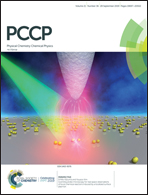Strain-tunable CO2 storage by black phosphorene and α-PC from combined first principles and molecular dynamics studies†
Abstract
2D layered materials are intrinsically promising mediums for gas adsorption because of their recognized large surface areas and structural stability. Their gas adsorption and desorption processes are usually controlled by changing the temperature or applying high voltage. In this work, though combined density functional theory (DFT) calculations and molecular dynamics (MD) simulations, we propose that external tensile strain can also regulate the gas binding energetics and kinetics using two representative 2D materials, monolayer black phosphorene (BP) and black phosphorus carbide (α-PC), as showpiece models. The DFT results clearly show that CO2 can be physically adsorbed on BP/α-PC with moderate binding strength, which facilities the adsorption and desorption processes. For BP, strain increases the storage capacity from 10.90 ± 0.28 mmol g−1 (strain free) to 12.67 ± 0.33 (30% strain) with a tunability of 16.2%. α-PC, however, has a smaller strain response; its CO2 storage capacity increases from 15.98 ± 0.34 mmol g−1 (strain free) to 17.15 ± 0.36 mmol g−1 for a 10% strained state. DFT calculations reveal that CO2 is an electron acceptor for both BP and α-PC; however, it hardly regulates their electronic structures. The theoretical investigations suggest that BP and α-PC have great potential as gas capture and storage materials. The strain controlling approach can be generalized for the design of tunable nano-devices by external mechanical stimuli.



 Please wait while we load your content...
Please wait while we load your content...